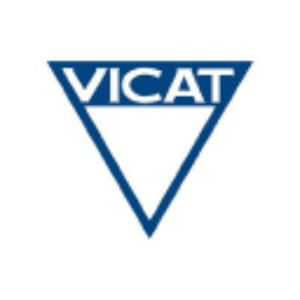Vicat: First-half 2022 Results
L’ISLE-D'ABEAU,
Vicat (Paris:VCT):
- Solid sales growth: demand holding up at high levels, strong increase in selling prices
-
Profitability adversely affected by the significant increase in energy costs and non-recurring industrial costs in
the United States ,France andIndia - Solid cash generation and robust balance sheet despite the inflated increase in the working capital requirement
Condensed income statement approved by the Board of Directors on
(€ million) |
H1 2022 |
H1 2021 |
Change
|
Change
|
Consolidated sales |
1,755 |
1,560 |
+ |
+ |
EBITDA |
269 |
300 |
- |
- |
Margin (%) |
|
|
|
|
EBIT |
128 |
171 |
- |
- |
Margin (%) |
|
|
|
|
Consolidated net income |
88 |
102 |
- |
- |
Margin (%) |
|
|
|
|
Net income, Group share |
78 |
94 |
- |
- |
Cash flows from operations |
218 |
240 |
- |
- |
Commenting on these figures,
The Group is adapting to this environment by diversifying its procurement sources, honing the energy efficiency of its manufacturing facilities and pursuing a pricing strategy tailored to each specific region in which it operates. The Group is also moving forward with its policy of lowering its greenhouse gas emissions by harnessing existing solutions and investing in technologies that will enable it to reach its 2030 and 2050 targets.”
Disclaimer:
- In this press release, and unless indicated otherwise, all changes are stated on a year-on-year basis (2022/2021), and at constant scope and exchange rates.
- The alternative performance measures (APMs), such as “at constant scope and exchange rates”, “operational sales”, “EBITDA”, “EBIT”, “net debt”, “gearing” and “leverage” are defined in the appendix to this press release.
- This press release may contain forward-looking statements. Such forward-looking statements do not constitute forecasts regarding results or any other performance indicator, but rather trends or targets. These statements are by their nature subject to risks and uncertainties as described in the Company’s annual report available on its website (www.vicat.fr). These statements do not reflect the future performance of the Company, which may differ significantly. The Company does not undertake to provide updates on these statements.
Further information about Vicat is available from its website (www.vicat.fr).
-----------------------------------------------------------------------------------------------------------------------------------
In an environment characterised by very strong inflation in its costs, Vicat’s first-half 2022 sales posted a substantial increase resulting from a large rise in selling prices, which offset to a significant degree the contraction in volumes delivered.
This performance reflected:
-
a high basis for comparison in the first half of 2021, especially in
France ,India ,Brazil andKazakhstan ; -
a steep decline in volumes delivered in
Turkey to curb the impact of higher energy costs; -
the impact of non-recurring costs in
the United States ,France andIndia ; -
the consequences of the geopolitical environment in
Mali .
Overall, the Group’s consolidated sales totalled
The trend in consolidated sales on a reported basis reflects:
-
a scope effect of -
1.4% (negative impact of -€25 million ), resulting from the sale of the lightweight precast business inSwitzerland , which was finalised on30 June 2021 ; -
an unfavourable currency effect of -
0.4% , representing a negative impact of -€6 million over the first half owing to the depreciation of the Turkish lira and the Egyptian pound; compensated by that of the euro against other currencies; -
organic growth of +
12.9% (+€227 million ) driven by increases in selling prices across the regions.
The Group’s operational sales totalled
Vicat’s consolidated EBITDA came to
At constant scope and exchange rates, the decline in EBITDA was the result of an unfavourably high basis for comparison in the first half of 2021 and of the very strong inflation in production costs, especially energy, since the second half of 2021, with a significant acceleration in 2022. As a result, energy costs moved up +
EBIT came to
Operating income came to
The +
The macroeconomic and inflationary situation in
-
re-evaluation of the opening balance sheet at
1 January 2022 , leading to an +€85 million impact on the Group’s share of equity; -
an impact on the first-half 2022 income statement of -
€4.3 million via net financial income (expense).
Tax expense declined
Consolidated net income was
Net income, Group share fell -
Cash flow from operations came to
1. Income statement analysed by geographical region
1.1. Income statement,
(€ million) |
H1 2022 |
H1 2021 |
Change
|
Change
|
Consolidated sales |
606 |
562 |
+ |
+ |
EBITDA |
80 |
104 |
- |
- |
EBIT |
31 |
66 |
- |
- |
During the first half of 2022, the Group’s sales in
Conversely, EBITDA in
-
In the Cement business, operational sales rose +
6.8% at constant scope. Given the unfavourable basis of comparison resulting from the French market’s dynamic performance in the same period of last year, this increase reflects a slight drop-off in demand offset by a sharp rise in selling prices at the beginning of the year.
Even so, the series of price increases introduced at the beginning of the year and late in the second quarter have for the time being offset only partially the very strong rise in energy costs, especially the cost of electricity. One-off maintenance operations carried out in a period of high activity levels after the two-year-long Covid-19 pandemic incurred non-recurring costs. The EBITDA generated by the Cement business declined by -
-
The operational sales recorded by the Concrete & Aggregates business rose +
5.2% at constant scope. This performance reflects a significant improvement in selling prices during the first half. Demand remained solid in concrete but weakened in aggregates.
Given the increase in costs, the EBITDA generated by the business fell -
-
In the Other Products & Services business, operational sales advanced +
7.8% at constant scope over the period. The Group completed the capacity increase at the Auneau plant in theParis region, which specialises in building chemicals (Vicat Industrial Products). This investment, which has increased mortar production capacity by 150 thousand tonnes p.a., will help meet the strong demand in theParis market and cut logistics costs significantly. The EBITDA recorded by the business fell -12.3% over the period.
1.2 Income statement for
(€ million) |
H1 2022 |
H1 2021 |
Change
|
Change
|
Consolidated sales |
184 |
203 |
- |
+ |
EBITDA |
41 |
39 |
+ |
+ |
EBIT |
25 |
19 |
+ |
+ |
Business trends in
In
-
In the Cement business, operational sales rose +
2.6% at constant scope and exchange rates. This performance reflects a contraction in demand during the first half, largely offset by a solid increase in selling prices.
Given these factors and despite the strong increase in energy costs, especially the cost of electricity, the EBITDA generated by this business grew by +
-
In the Concrete & Aggregates business, operational sales declined -
1.3% at constant scope and exchange rates. Selling prices moved higher in concrete and remained stable in aggregates. Although concrete volumes dropped off, aggregates volumes moved significantly higher.
As a result of these factors, the EBITDA generated by this business fell -
-
In the Other Products & Services business, operational sales rose by +
1.3% at constant scope and exchange rates, supported by a healthy level of deliveries in the rail sector and a favourable product mix. The EBITDA generated by the business surged higher (up +31.8% ) at constant scope and exchange rates over the first half.
In
1.3 Income statement for the
(€ million) |
H1 2022 |
H1 2021 |
Change
|
Change
|
Consolidated sales |
401 |
319 |
+ |
+ |
EBITDA |
55 |
70 |
- |
- |
EBIT |
22 |
43 |
- |
- |
Demand across the
In the
Construction of the new 5,000-tonne per day kiln line at the
-
In the Cement business, operational sales in the region grew +
5.3% at constant scope and exchange rates during the period, reflecting the strength of the construction market in the regions in which the Group operates and a significant increase in selling prices.
Even so, given the surge in energy costs and the additional non-recurring adjustment costs linked to the start-up of the
-
In the Concrete business, operational sales rose +
4.3% at constant scope and exchange rates as further positive market trends continued to provide support. Against this backdrop, selling prices moved significantly higher. Nonetheless, EBITDA fell -47.6% at constant scope and exchange rates over the period as a result of the higher costs. Given the stretched cement supply conditions inAlabama , the profitability of this business in the region was indirectly affected by the start-up of theRagland plant’s new kiln.
In
-
In the Cement business, operational sales were
€101 million , an increase of +29.6% at constant scope and exchange rates, supported by robust demand and a large increase in selling prices. Nonetheless, higher selling prices only partially made up for the very strong increase in energy costs. Consequently, EBITDA fell -41.5% at constant scope and exchange rates. -
In the Concrete & Aggregates business, operational sales were
€41 million , an increase of +53.8% at constant scope and exchange rates, in line with the trends seen in the Cement business. Market conditions remained favourable throughout the period, and they were supported by an increase in concrete and aggregates selling prices. As a result, the EBITDA generated over the period surged +69.8% at constant scope and exchange rates.
1.4
(€ million) |
H1 2022 |
H1 2021 |
Change
|
Change
|
Consolidated sales |
249 |
206 |
+ |
+ |
EBITDA |
52 |
58 |
- |
- |
EBIT |
35 |
40 |
- |
- |
Sales in
Consolidated sales in
1.5 Mediterranean (
(€ million) |
H1 2022 |
H1 2021 |
Change
|
Change
|
Consolidated sales |
145 |
103 |
+ |
+ |
EBITDA |
16 |
-6 |
n.s. |
n.s. |
EBIT |
9 |
-16 |
n.s. |
n.s. |
In the Mediterranean region, sales moved sharply higher in both countries amid a situation that still lacks visibility. The key factor behind the increase was a large hike in selling prices, paving the way for operating profitability to pick up with contrasting situations.
In
EBITDA recorded a significant increase over the first six months to reach
-
In the Cement business, the far less favourable weather conditions than in the first quarter of 2021 impacted business trends. In a hyperinflationary environment, the Group has limited the use it makes of its least energy-efficient manufacturing facilities to lower the impact of higher costs. As a result, volumes delivered were much lower during the period, even though demand remains solid. The volume decline was offset to a very large extent by very substantial price hikes. As a result, operational sales climbed +
135.3% at constant scope and exchange rates to€65 million .
Given these factors, the EBITDA generated by this business totalled over
-
In the Concrete & Aggregates business, operational sales rose +
163.7% at constant scope and exchange rates to€45 million . As in the Cement business, tough weather conditions at the beginning of the year curbed concrete and aggregates deliveries during the first half, even though the impact of these reductions was offset to a very large degree by the significant rise in selling prices.
The first-half EBITDA generated by the business came to
In
As a result of these factors and in line with trends seen the second half of 2021, the first-half EBITDA generated in
1.6
(€ million) |
H1 2022 |
H1 2021 |
Change
|
Change
|
Consolidated sales |
170 |
167 |
+ |
+ |
EBITDA |
24 |
35 |
- |
- |
EBIT |
6 |
18 |
- |
- |
In
-
In the Cement business, operational sales in the
Africa region fell -4.2% at constant scope and exchange rates. While business trends were stable inSenegal , the sharp contraction in Mali’s market as a result of the geopolitical environment was not fully offset by growth inMauritania . Selling prices rose across each of these markets, but the size of the increases was significantly restricted by the authorities inSenegal during the election period.
Given the very strong inflation in production costs, the EBITDA generated by the business declined -
-
In
Senegal , the Aggregates business, supported by private sector construction projects, recorded operational sales of€18 million , up +19.5% at constant scope and exchange rates. Selling prices moved lower due to an unfavourable product and customer mix.
As a result of these factors, EBITDA decreased by -
2. Changes in the Group’s financial position at
At
Net financial debt stood at
On this basis, the Group’s leverage ratio stood at 2.84x at
The average interest rate on gross debt as of
Medium- to long-term borrowings are subject to special clauses (covenants) requiring certain financial ratios to be met. Given the level of Group’s net debt and balance sheet liquidity, the bank covenants do not pose a risk for the Group’s financial position. At
3. Capital expenditure and free cash flow
Capital expenditure totalled
As a result, free cash flow amounted to -
4. Recent events
4.1 Start-up of the
The construction of a new 5,000-tonne/day kiln at the
It’s a production project with multiple dimensions:
-
the new kiln will provide the additional capacity needed to meet the needs of the Group’s markets in the South-East region of
the United States , by increasing the plant’s capacity to 1.8 million tonnes p.a., from 1.2 million tonnes previously; -
the highly energy-efficient technology used will lower production costs by around
30% per tonne produced; and - the new kiln will actively help the Group to meet its carbon emission reduction targets because of its higher electrical efficiency and the switch from coal to alternative fuels
4.2 Construction of a new kiln in
The Group, via its subsidiary
- a significant increase in the Group’s clinker capacity in the sub-region;
-
a very significant improvement in the manufacturing performance of all its operations in
Senegal ; - an active contribution towards meeting the Group’s carbon emission reduction targets, through its ability to make wholesale use of alternative fuels.
The new production facility is scheduled for commissioning in 2024.
4.3 Further milestone reached in the development of « CARAT », the first zero-carbon binder
On 12 January, the
« CARAT », the first carbon-negative binder, will enrich Vicat’s DECA range of low-carbon solutions, raising the prospect of very low-carbon concrete, with a reduction of close to
To achieve these performances, Vicat’s innovation team developed techniques (some covered by ongoing patent applications) that create formulated cement products with two key ingredients:
- the Group’s clinker with the smallest possible carbon footprint;
- biochar, a well-known means of sequestering carbon, manufactured from forestry and agricultural waste. These materials replace part of the clinker in the binder and thus contribute to its very small carbon footprint.
Vicat is working with the Soler group and its Carbonex subsidiary to source the biochar. By using this “carbon sink” component, « CARAT » achieves the following net carbon emission levels:
- binder 0133H, with a technical performance similar to that of a 42.5 R cement, has a value of -15 kg CO2 per tonne;
- binder 2402H, with a technical performance similar to that of a 32.5 R cement, has a value of -310 kg CO2 per tonne.
Following the testing of works to qualify the performance of concrete formulated with this binder and validating its use, the Vicat group has conducted larger-scale demonstration projects. The projects completed in March and
Initially, « CARAT » will be produced at the Montalieu-Vercieu cement plant in
5. Outlook for 2022
In 2022, the Group anticipates a strong increase in its sales underpinned by an increase in its activity levels and a large hike in selling prices. The EBITDA generated by the Group in 2022 is likely to grow, but not by as much as in 2021. In the light of these factors, the Group expects erosion in its EBITDA margin in 2022.
The following key trends are anticipated in the second half of 2022:
- a less unfavourable basis for comparison, especially for energy costs;
-
the full impact of the various price hikes introduced in
France andSwitzerland at the end of the first six months and inthe United States at the beginning of the third quarter; -
further steady price hikes in emerging markets, except for
Senegal andEgypt , since decisions to raise prices in these countries are subject to government approvals; -
The gradual ramp-up in the
Ragland plant’s new kiln line and the non-recurrence of the additional start-up costs linked to its commissioning. -
The increase in capacity of
Kalburgi Cement after debottlenecking operations - The ramp up of the new production line of the VPI Auneau plant
During the second half of 2022, the Group will keep up its investment drive, focusing chiefly on:
-
the start of construction work on the new kiln (Kiln 6) in
Senegal ; -
the pursuit of projects to meet carbon footprint reduction targets (e.g. the Argilor project in
France or the construction of a Waste Heat Recovery system inTurkey ); -
debottlenecking operations to boost capacity at production facilities at Kalburgi in
India and to invest in new terminals to expand its market and lower logistics costs.
Accordingly, capital expenditure is expected to be higher than in 2021 at around
The Group wishes to make clear that these anticipated trends per country are highly dependent on the latest developments in the pandemic and on the impact of the war in
-
In
France , activity levels are expected to hold up at a high level throughout the year, supported by a macroeconomic environment that should remain favourable for the construction sector. As a result, the Group expects its volumes to be stable and its prices to rise markedly to offset the impact of higher energy costs, especially electricity; -
In
Switzerland , the Cement and the Concrete & Aggregates businesses should reap the benefit of upbeat conditions in the construction sector. As inFrance , the Group expects a sharp increase in electricity costs offset by higher selling prices. -
In
the United States , both volumes and selling prices are expected to continue increasing. The impact of the economic stimulus plan being rolled by the US administration is likely to be felt gradually from the second half of this year. In this market, the Group is expected to reap the benefit of the ramp-up in theRagland plant’s new kiln during the second half; -
In
Brazil , business and profitability levels in 2021 set a high basis of comparison in a market in which trends are expected to remain nonetheless favourable. As a result, the Group expects broadly stable business volumes over the year as a whole, plus a further increase in prices; -
In
India , the macroeconomic and sector environment is expected to remain favourable. With prices remaining highly volatile, the strong rise in energy costs is only likely to be partially offset; -
In
Kazakhstan , market conditions are expected to remain favourable despite a high basis for comparison and the Group’s performances should improve further; -
In
Turkey , the situation is expected to keep improving gradually in 2022, subject to trends in the Turkish lira and interest rates. The very strong hike in prices should help offset the rise in energy costs and improve operational profitability; -
In
Egypt , amid a gradually improving industry environment, the Group’s performance over the year remains subject to the measures implemented by the government to restore a healthier market environment being kept in place. -
In
West Africa , trends in Cement are expected to remain dynamic, with support from a favourable sector environment, despite the moderating impact of the Senegalese authorities’ freeze on prices. Note that the geopolitical situation inMali is likely to gradually improve as a result of the recent reopening of the country’s borders. The Aggregates business inSenegal is likely to continue its recovery.
Presentation meeting and conference call
To accompany this publication, the Vicat group is holding an information conference call in English on
To take part in the conference call live, dial in on one of the following numbers:
US: +1 212 999 6659
The conference call will also be livestreamed from the www.vicat.fr website. A replay of the conference call will be immediately available for streaming via the Vicat website or by clicking here.
The presentation supporting the event will be available on Vicat’s website or by clicking here from
Next event:
Third-quarter 2022 sales on
About Vicat
Vicat group – Financial data – Appendix
Definition of alternative performance measures (APMs):
- Performance at constant scope and exchange rates is used to determine the organic growth trend in P&L items between two periods and to compare them by eliminating the impact of exchange rate fluctuations and changes in the scope of consolidation. It is calculated by applying exchange rates and the scope of consolidation from the prior period to figures for the current period.
- A geographical (or a business) segment’s operational sales are the sales posted by the geographical (or business) segment in question less intra-region (or intra-segment) sales.
- Value-added: value of production less consumption of materials used in the production process.
- Gross operating income: value-added, less staff costs, taxes and duties (other than on income and deferred taxes).
- EBITDA (earnings before interest, tax, depreciation and amortisation): sum of gross operating income and other income and expenses on ongoing business.
- EBIT: (earnings before interest and tax): EBITDA less net depreciation, amortisation, additions to provisions and impairment losses on ongoing business.
- Cash flow from operations: net income before net non-cash expenses (i.e. predominantly depreciation, amortisation, additions to provisions and impairment losses, deferred taxes, gains and losses on disposals and fair value adjustments).
- Free cash flow: net operating cash flow after deducting capital expenditure net of disposals.
- Net debt represents gross debt (consisting of the outstanding amount of borrowings from investors and credit institutions, residual financial liabilities under finance leases, any other borrowings and financial liabilities excluding options to sell and bank overdrafts), net of cash and cash equivalents, including remeasured hedging derivatives and debt.
- Gearing is a ratio reflecting a company’s financial structure calculated as net debt/consolidated equity.
- Leverage is a ratio based on a company’s profitability, calculated as net debt/consolidated EBITDA.
Income statement by business
Cement
|
(€ million) |
H1 2022 |
H1 2021 |
Change
|
Change
|
||
Volume (thousands of tonnes) |
13,457 |
14,069 |
- |
|
||
Operational sales |
1,095 |
938 |
+ |
+ |
||
Consolidated sales |
937 |
804 |
+ |
+ |
||
EBITDA |
192 |
215 |
- |
- |
||
EBIT |
105 |
139 |
- |
- |
||
Cement sales recorded a significant increase during the first six months of 2022, supported by a very tangible hike in selling prices, which paved the way for a contraction in volumes sold, chiefly in
To date, the hefty increase in prices has sufficed only to offset partially the very strong inflation in production costs, especially energy, during the first six months of the year, together with certain non-recurring costs in
Concrete & Aggregates
| (€ million) | H1 2022 |
H1 2021 |
Change
|
Change
|
Concrete volumes
|
4,957 |
5,119 |
- |
|
Aggregates volumes
|
12,049 |
11,941 |
+ |
|
Operational sales |
675 |
585 |
+ |
+ |
Consolidated sales |
659 |
569 |
+ |
+ |
EBITDA |
63 |
70 |
- |
- |
EBIT |
18 |
27 |
- |
- |
In line with the increase in Cement, the operational sales recorded by the Concrete & Aggregates business moved significantly higher during the first half. This performance reflects a solid increase in selling prices. Although concrete volumes fell slightly, aggregates volumes rose.
Taking these factors and the significant rise in production costs into account, the EBITDA recorded by the business declined, and the EBITDA margin on operational sales contracted by -260 basis points to
Other Products & Services
(€ million) |
H1 2022 |
H1 2021 |
Change
|
Change
|
||
Operational sales |
226 |
249 |
- |
+ |
||
Consolidated sales |
158 |
187 |
- |
+ |
||
EBITDA |
14 |
16 |
- |
+ |
||
EBIT |
6 |
5 |
+ |
+ |
||
Trends in the Other Products and Services business recorded an increase in the first half.
EBITDA rose +
Principal 2022 financial statements
The full set of consolidated financial statements for the first six months of 2022, together with the notes, are now available on the Company’s website at: www.vicat.fr.
Consolidated Income Statement
| (in thousands of euros) | Notes |
|||||
|
||||||
| Revenue | 4 |
1,754,520 |
1,559,667 |
|||
| Goods and services purchased |
|
(1,202,784) |
(992,025) |
|||
| Added value |
|
551,737 |
567,642 |
|||
| Employees expenses | 5 |
(260,382) |
(250,214) |
|||
| Taxes |
|
(35,688) |
(34,644) |
|||
| Gross operating income |
|
255,666 |
282,784 |
|||
| Other operating income (expenses) | 6 |
13,217 |
17,248 |
|||
| EBITDA |
|
268,884 |
300,032 |
|||
| Net charges to operating depreciation, amortization and provisions | 7 |
(140,389) |
(128,844) |
|||
| EBIT |
|
128,495 |
171,188 |
|||
| Other non-operating income (expenses) | 6 |
116 |
(17,592) |
|||
| Net charges to non-operating depreciation, amortization and provisions | 7 |
(540) |
7,483 |
|||
| Operating income (expense) |
|
128,071 |
161,079 |
|||
| Cost of net financial debt |
|
(2,333) |
(16,647) |
|||
| Other financial income |
|
16,677 |
7,403 |
|||
| Other financial expenses |
|
(24,074) |
(8,519) |
|||
| Financial income | 8 |
(9,730) |
(17,763) |
|||
| Share of profit (loss) of associates |
|
4,439 |
3,154 |
|||
| Profit (loss) before tax |
|
122,780 |
146,470 |
|||
| Income tax | 9 |
(34,971) |
(44,589) |
|||
| Consolidated net income |
|
87,810 |
101,881 |
|||
| Portion attributable to minority interests |
|
10,027 |
8,339 |
|||
| Portion attributable to the Group |
|
77,783 |
93,542 |
|||
|
||||||
| EARNINGS PER SHARE (in euros) |
|
|||||
| Basic and diluted earnings per share |
|
1.73 |
2.08 |
Comprehensive income
| (in thousands of euros) | ||||
| Consolidated net income | 87,810 |
101,881 |
||
| Other items not recycled to profit or loss: | ||||
| Remeasurement of the net defined benefit liability | 89,612 |
8,656 |
||
| Tax on non-recycled items | (18,579) |
(2,336) |
||
| Other items recycled to profit or loss: | ||||
| Changes in currency translation adjustments | 106,490 |
29,862 |
||
| Cash flow hedge instruments | (1,776) |
1,075 |
||
| Tax on recycled items | 505 |
(278) |
||
| Other comprehensive income (after tax) | 176,252 |
36,979 |
||
| TOTAL COMPREHENSIVE INCOME | 264,062 |
138,860 |
||
| Portion attributable to minority interests | 18,909 |
12,826 |
||
| Portion attributable to the Group | 245,153 |
126,034 |
Financial Position
| ASSETS |
|
|||||
| (in thousands of euros) | Notes |
|||||
|
||||||
10.1 |
1,235,018 |
1,157,232 |
||||
| Other intangible assets | 10.2 |
186,018 |
173,653 |
|||
| Property, plant and equipment | 10.3 |
2,415,855 |
2,169,041 |
|||
| Right of use related to leases | 10.4 |
192,053 |
195,112 |
|||
| Investment properties | 10.5 |
32,202 |
32,218 |
|||
| Investments in associated companies | 11.1 |
104,114 |
92,774 |
|||
| Deferred tax assets | 9 |
104,033 |
68,012 |
|||
| Receivables and other non-current financial assets | 11.2 |
250,145 |
219,241 |
|||
| Total non-current assets |
|
4,519,437 |
4,107,283 |
|||
| Inventories and work-in-progress | 12.1 |
552,643 |
429,243 |
|||
| Trade and other accounts | 12.2 |
615,301 |
436,219 |
|||
| Current tax assets | 9 |
11,497 |
6,947 |
|||
| Other receivables | 12.3 |
218,928 |
206,475 |
|||
| Cash and cash equivalents | 13 |
481,034 |
527,393 |
|||
| Total current assets |
|
1,879,404 |
1,606,277 |
|||
|
||||||
| TOTAL ASSETS |
|
6,398,841 |
5,713,560 |
|||
|
||||||
| SHAREHOLDERS’ EQUITY AND LIABILITIES |
|
|||||
|
||||||
| (in thousands of euros) | Notes |
|||||
|
||||||
| Capital |
|
179,600 |
179,600 |
|||
| Additional paid-in capital |
|
11,207 |
11,207 |
|||
|
(48,864) |
(52,018) |
||||
| Consolidated reserves |
|
2,948,344 |
2,800,579 |
|||
| Translation reserves |
|
(474,092) |
(579,950) |
|||
| Shareholders’ equity, Group share |
|
2,616,195 |
2,359,418 |
|||
| Minority interests |
|
279,899 |
246,681 |
|||
| Total shareholders’ equity | 14 |
2,896,094 |
2,606,099 |
|||
| Provisions for pensions and other post-employment benefits | 15.1 |
24,018 |
108,529 |
|||
| Other provisions | 15.2 |
114,396 |
104,974 |
|||
| Financial debts and put options | 16.1 |
1,588,965 |
1,291,434 |
|||
| Lease liabilities | 16.1 |
151,906 |
159,883 |
|||
| Deferred tax liabilities |
|
306,499 |
219,800 |
|||
| Other non-current liabilities |
|
25,459 |
23,927 |
|||
| Total non-current liabilities |
|
2,211,242 |
1,908,547 |
|||
| Provisions | 15.2 |
11,214 |
10,381 |
|||
| Financial liabilities and put options at less than one year | 16.1 |
410,455 |
371,119 |
|||
| Lease liabilities at less than one year | 16.1 |
57,439 |
55,502 |
|||
| Trade and other accounts payable | 17 |
502,417 |
459,647 |
|||
| Current taxes payable |
|
19,157 |
27,558 |
|||
| Other liabilities |
|
290,823 |
274,707 |
|||
| Total current liabilities |
|
1,291,505 |
1,198,914 |
|||
| Total liabilities |
|
3,502,747 |
3,107,461 |
|||
|
||||||
| TOTAL LIABILITIES AND SHAREHOLDERS’ EQUITY |
|
6,398,841 |
5,713,560 |
Cash Flows
| (in thousands of euros) | Notes |
|||||
| CASH FLOWS FROM OPERATING ACTIVITIES |
|
|||||
|
||||||
| Consolidated net income |
|
87,810 |
101,881 |
|||
|
||||||
| Share of profit (loss) of associates |
|
(4,439) |
(3,154) |
|||
| Dividends received from associated companies |
|
2,345 |
1,073 |
|||
| Elimination of non-cash and non-operating items: |
|
|||||
| - depreciation, amortization and provisions |
|
140,124 |
121,010 |
|||
| - deferred taxes |
|
1,315 |
5,261 |
|||
| - net gain (loss) from disposal of assets |
|
(1,959) |
(3,437) |
|||
| - unrealized fair value gains (losses) |
|
(12,662) |
62 |
|||
| - others (1) |
|
5,445 |
17,128 |
|||
|
||||||
| Cash flows from operating activities |
|
217,979 |
239,824 |
|||
|
||||||
| Change in working capital |
|
(242,102) |
(122,035) |
|||
|
||||||
| Net cash flows from operating activities (2) | 18.1 |
(24,123) |
117,789 |
|||
|
||||||
| CASH FLOWS FROM INVESTING ACTIVITIES |
|
|||||
|
||||||
| Outflows linked to acquisitions of non-current assets: |
|
|||||
| - tangible and intangible assets |
|
(182,507) |
(177,339) |
|||
| - financial investments |
|
(21,481) |
(8,839) |
|||
|
||||||
| Inflows linked to disposals of non-current assets: |
|
|||||
| - tangible and intangible assets |
|
4,031 |
7,033 |
|||
| - financial investments |
|
1,463 |
657 |
|||
|
||||||
| Impact of changes in consolidation scope |
|
(40,034) |
9,915 |
|||
|
||||||
| Net cash flows from investing activities | 18.2 |
(238,528) |
(168,573) |
|||
|
||||||
| CASH FLOWS FROM FINANCING ACTIVITIES |
|
|||||
|
||||||
| Dividends paid |
|
(78,820) |
(73,974) |
|||
| Increases/decreases in capital |
|
|||||
| Proceeds from borrowings | 14 |
373,269 |
151,673 |
|||
| Repayments of borrowings | 14 |
(33,129) |
(29,315) |
|||
| Repayment of lease liabilities | 14 |
(28,815) |
(25,865) |
|||
| Acquisitions of treasury shares |
|
(11,525) |
(11,543) |
|||
| Disposals or allocations of treasury shares |
|
13,346 |
14,073 |
|||
|
||||||
| Net cash flows from financing activities |
|
234,326 |
25,049 |
|||
| Impact of changes in foreign exchange rates |
|
2,475 |
3,848 |
|||
| Change in cash position |
|
(25,850) |
(21,887) |
|||
| Net cash and cash equivalents - opening balance | 13.2 |
430,442 |
359,159 |
|||
| Net cash and cash equivalents - closing balance | 13.2 |
404,700 |
337,271 |
'(1) :
'- Including IAS 29 impacts (cf. Note 1.1)
'(2) :
'- Including cash flows from income taxes: € () million as of
'- Cash flows from interests paid and received: € () million as of
Changes in Consolidated Shareholders’ Equity
| (in thousands of euros) | Capital | Additional paid-in capital |
shares |
Consolidated reserves |
Translation reserves |
Shareholders' equity, Group share |
Minority interests |
Total shareholders' equity |
||||
| At |
179,600 |
11,207 |
(53,587) |
2,679,297 |
(640,130) |
2,176,387 |
234,306 |
2,410,693 |
||||
| Half year net income | 93,542 |
93,542 |
8,339 |
101,881 |
||||||||
| Other comprehensive income (2) | 9,066 |
23,426 |
32,492 |
4,487 |
36,979 |
|||||||
| Total comprehensive income | 102,608 |
23,426 |
126,034 |
12,826 |
138,860 |
|||||||
| Dividends paid | (66,187) |
(66,187) |
(7,876) |
(74,063) |
||||||||
| Net change in treasury shares | 1,808 |
507 |
2,315 |
2,315 |
||||||||
| Change in consolidation scope and additional acquisitions |
(13,327) |
(13,327) |
(3,057) |
(16,384) |
||||||||
| Other changes | (2,701) |
(2,701) |
(90) |
(2,791) |
||||||||
| At |
179,600 |
11,207 |
(51,779) |
2,700,197 |
(616,704) |
2,222,521 |
236,109 |
2,458,630 |
||||
| At |
179,600 |
11,207 |
(52,018) |
2,800,579 |
(579,950) |
2,359,418 |
246,681 |
2,606,099 |
||||
| Net income | 77,783 |
77,783 |
10,027 |
87,810 |
||||||||
| Other comprehensive income (2) | 61,511 |
105,859 |
167,370 |
8,882 |
176,252 |
|||||||
| Total comprehensive income | 139,294 |
105,859 |
245,153 |
18,909 |
264,062 |
|||||||
| Dividends paid | (72,613) |
(72,613) |
(8,981) |
(81,594) |
||||||||
| Net change in treasury shares | 3,154 |
(1,378) |
1,776 |
1,776 |
||||||||
| Changes in scope of consolidation and additional acquisitions |
(6,889) |
(6,889) |
(3,170) |
(10,059) |
||||||||
| Adjustments related to the application of IAS 29 (1) | ||||||||||||
| Other changes | 4,149 |
4,149 |
15,566 |
19,715 |
||||||||
| At |
179,600 |
11,207 |
(48,864) |
2,948,343 |
(474,091) |
2,616,195 |
279,899 |
2,896,094 |
'(1) The impact of the application of IAS 29 is detailed in note 1.1
'(2) Breakdown by nature of other comprehensive income:
Other comprehensive income includes mainly cumulative translation adjustments from end 2003. To recap, applying the option offered by IFRS 1, the conversion
differences accumulated before the transition date to IFRS were reclassified by allocating them to retained earnings as at that date.
The Group’s translation reserves break down by foreign currency at
| (in thousands of euros) | ||||
| US dollar | 89,486 |
19,754 |
||
| Swiss franc | 246,646 |
186,194 |
||
| Turkish lira | (349,470) |
(304,901) |
||
| Egyptian pound | (133,478) |
(124,233) |
||
| Kazakh tenge | (112,088) |
(95,164) |
||
| Mauritanian ouguiya | (4,904) |
(8,837) |
||
| Brazilian real | (56,999) |
(82,556) |
||
| Indian rupee | (153,284) |
(206,961) |
||
| TOTAL | (474,091) |
(616,704) |
View source version on businesswire.com: https://www.businesswire.com/news/home/20220727005456/en/
Investor relations contact:
Tel + 33 (0)1 58 86 86 05
stephane.bisseuil@vicat.fr
Press contacts:
Karine Boistelle-Adnet
Tel +33 (0)4 74 27 58 04
karine.boistelleadnet@vicat.fr
Source: Vicat








